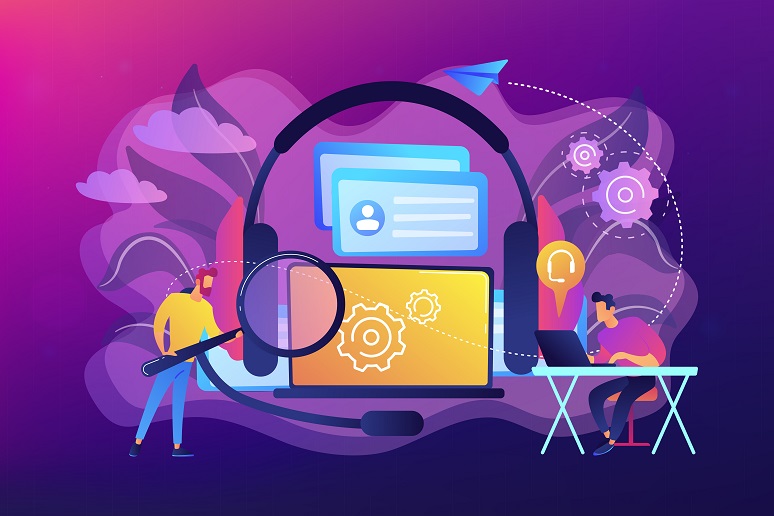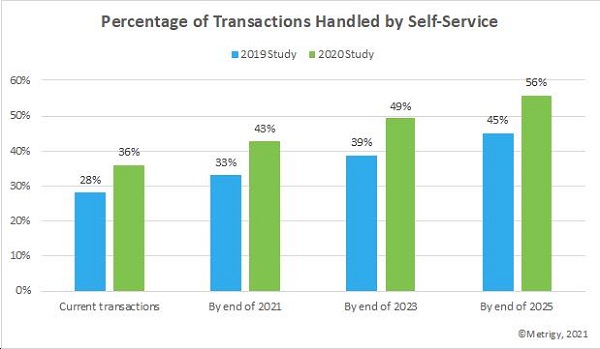Businesses continue to deliver virtual options for customers to buy products, visit the doctor, take a class, and address service issues. With fewer people visiting physical locations following the COVID-19 pandemic, contact centers have seen a surge in activity.
As a result, customer experience (CX) and IT leaders are focusing on self-service capabilities by improving knowledge bases and pairing them with virtual assistants to guide customers to resolution—with or without help from a live agent. The goal of self-service is to serve as many customers as possible without human intervention. It’s typically less expensive, and the customer satisfaction rate is higher because they get their answers quickly and in the format they want.
It’s crucial to note that self-service should never be the only option. Self-service journeys that are well-designed will have multiple hooks to escalate to live agents because ultimately, the goal is customer satisfaction. If that isn’t happening—and quickly—with self-service, it’s imperative to bring in live assistance. Customers or an AI-based virtual assistant can decide when live agents are required.
Drivers for Self-Service
By the end of 2020, 32.8% of organizations were using AI-enabled self-service, according to Metrigy’s Customer Engagement Transformation 2020-21 research study of 700 organizations. By the end of 2021, another 34.3% of organizations were planning to do the same. Between 2019 and 2020, there was a 28.6% growth in the number of transactions handled by self-service (from 28% to 36%). By the end of 2023, 49% of all transactions will be self-service, according to the research participants (see image below).
What drives customer demand for self-service, and businesses to invest in it? Several things, including the following:
- Customers get what they need as soon as possible. This has been crucial since the start of the pandemic, as the agent pool was thin while they were setting up home offices and troubleshooting application and network performance. A well-designed self-service knowledge base or searchable chatbot frequently asked questions (FAQ) fill in the gaps.
- Self-service improves the user experience. Using AI coupled with multimedia content delivery customers can get customized, feature-rich information that addresses questions, solves problems, or provides product information.
- Businesses generate revenue. By adding predictive analysis tools, organizations can have self-service virtual assistants make purchasing recommendations as if customers want refills, or suggest item pairing based on buying patterns.
- Technology automation helps reduce operating costs. Over time, the cost of self-service applications and associated infrastructure is less than live agents handling the same number of inquiries.
Getting Started with Self-Service
Self-service can cover many different areas of customer support. Typically, we see companies running knowledge bases (which contain answers to questions), product or warranty information, case studies, pricing, troubleshooting guides, and more. They also use virtual assistants or chatbots to route inquiries, assist a customer who is struggling on an app or the website, schedule or change appointments, and narrow down the customer’s request to route the inquiry to the right area.
CX leaders sometimes make the mistake of adding a virtual assistant to an aging self-service knowledge base. Before doing this, the CX and content management teams must take a few steps.
First, update the knowledge base itself. Most are outdated in terms of content, applications, usability, searching abilities, and user interfaces. Make sure the updates include multimedia content, with improved search functionality that matches common (and not so common) requests with the targeted content. This takes longer than most people allow. To engage the customer and provide information in a way that’s more than just blocks of text, content should include video, images, decision trees, diagrams, interactive Q&As, etc.
Next, walk through the customer journey possibilities and identify areas that would be ripe for customer frustration or problems. In those areas, add “hooks” to pull the customer out of the self-service world and into live agent support using webchat, video, voice, or other channels. It’s important to conduct testing and focus groups here to see how customers or prospective customers would journey through the self-service capabilities.
Finally, determine where it makes sense to add AI and machine learning. Chatbots are the most widely used self-service application, but others include language translation, predictive analytics, sentiment analysis, and Natural language processing. As machine learning continues to learn, the self-service experience should improve by pairing questions with the best content, adding more content to questions that regularly are escalated to live agents, or determining where customer frustration sets in. Then add an escalation hook.
Measure the Results
For self-service systems to drive business success, they need regular attention, analysis, and revisions. Once the system is up and running, the project isn’t done. The implementation may be, but the project is ongoing to keep up with changes in products, services, warranties, and especially customer demand.
Already, companies with AI-enabled self-service are seeing compelling results, including a 7.9% decrease in operational costs, 60.5% increase in revenue, 37.9% improvement in customer ratings, and 33.1% boost in agent efficiency. Measuring business success with self-service capabilities is a solid way to continue to receive funding for future CX projects.











